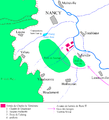Battle of Nancy
| date | January 5, 1477 |
|---|---|
| location | Nancy |
| exit | Victory of the Lorraine and the wages of the Confederation / Lower Association |
| Parties to the conflict | |
|---|---|
|
René II of Lorraine supported by mercenaries recruited from the Confederation and the Lower Association |
|
| Commander | |
|
Duke Charles the Bold of Burgundy †; Jacobo di Galeatto and Jost von Lalain , cavalry |
Wilhelm Herter von Hertneck , steward and field captain; Oswald von Thierstein , cavalry |
| Troop strength | |
| approx. 15,000 | approx. 19,000 |
| losses | |
|
approx. 5,000 |
unknown |
The Battle of Nancy on January 5, 1477 was the last clash of the Burgundian Wars between Duke Charles the Bold of Burgundy and the Lower Union , which in 1474 broke out between the Confederation , some Alsatian imperial cities, the Habsburg regent of Upper Austria , the Bishops of Basel and Strasbourg as well as the Duchy of Lorraine .
course
Duke Charles the Bold returned to Burgundy after the Battle of Murten and turned against the Duchy of Lorraine with a new army in the autumn of 1476. While besieging the Lorraine capital Nancy despite the onset of winter, the Lorraine Duke René II put together an army from his vassals and his allies from the Lower Union.
Near Nancy the Burgundian army hit of about 15,000 men to the squad René II. Totaling about 19,000 men on Jan. 5, 1477 together. Shortly before the battle, the supreme command of René von Lothringen was transferred to Wilhelm Herter and Oswald von Thierstein, as the council of the captains considered the duke, who was militarily inexperienced, to be overwhelmed. The troops were then re-formed. The Duke was assigned a protection force of 100 prudent Bernese who accompanied him during the battle. In the snowstorm, the allied mercenaries managed to occupy a hill on the flank of the Burgundian army. From there, around 8,000 Swiss and German mercenaries under the leadership of Wilhelm Herter took the positions of the entrenched Burgundians in an assault. Most of the Burgundian rank and file drowned in the Meurthe river . The survivors were followed to the gates of the Metz fortress .
While on the run, Charles the Bold was wounded, presumably by German mercenaries, with two lance sticks in the thigh and abdomen and then died of a blow that split his skull in two . His looted and disfigured body was found on the night of January 7 near a pond a few hundred meters from his position in battle. Duke René had Karl buried like a trophy in his court church St-Georges in Nancy. Two tablets add an anti-Burgundian note. The coffin was later transferred to the Church of Our Lady in Bruges.
The earliest representation of the battle in the contemporary Pfettisheim rhyming chronicle of 1477 shows the moment of the assault by the Austrian and federal mercenaries, who are led by Wilhelm Herter (recognizable by the pen).
Commemoration
The battlefield, then located in front of the city walls, is now overbuilt. To the south of Nancy is the Notre-Dame-de-Bonsecours church , a successor to the memorial chapel built on the battlefield immediately after the battle. To the west of the old town, at the point where Charles the Bold was found dead, he is commemorated by the Croix de Bourgogne memorial cross on the Place de la Croix-de-Bourgogne.
See also
literature
- Henri Dubois: Charles le Téméraire . Fayard, Paris 2004, ISBN 2-213-59935-1
- Historisch-Biographisches Lexikon der Schweiz , Volume 5. Neuchâtel 1929, p. 232.
- Klaus Schelle: Charles the Bold: Burgundy between lily banner and imperial eagle . Magnus, Essen 1976
- Theodor Schön: Wilhelm Herter von Herteneck . In: ReutlingerGbll 5, 1894, p. 96
- Bernhard Emanuel von Rodt : The campaigns of Charles the Bold and his heirs , Volume 2, Hurter, Schaffhausen 1843, p. 489–416 digitized version of the ULB Düsseldorf
Web links
- Claudius Sieber-Lehmann : Burgundy Wars. In: Historical Lexicon of Switzerland .
- Information page about the Burgundian Wars
photos
Individual evidence
- ↑ Bernhard Emanuel von Rodt : The campaigns of Charles the Bold and his heirs , Volume 2, Hurter, Schaffhausen 1843, p. 412–413 digitized version of the ULB Düsseldorf
- ^ Exhibition catalog Karl der Kühne, Belser, 2008, p. 340




